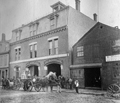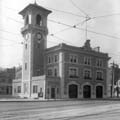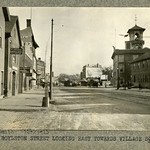|
The Society
Historical Information
Photo & Map Collections
Exploring Brookline
Links
Program Archives
|
Photo Collection
 |
Good Intent Hose Company, Lower Washington St., Brookline Village
Start of Boylston St. to the right going west; lower Washington St. toward Boston to the left. This brick building, constructed at significant cost, was completed in January 1872 and headed the town’s progression to a well-organized fire-fighting system after years of more haphazard efforts. It housed a hose carriage for the Good Intent Hose Company No. 1. and the Thomas Parsons Steam Fire Engine.
From stereoscope. "Engine and Hose House, Brookline. E.R. Hills, Photographer, Brookline Mass.” Gift of Natick Historical Society.
|
 |
Lower Washington St., circa 1875
Looking at the south side of Lower Washington St. High St. is just to the right. From left to right:
- Stores in the “White Block”
- Good Intent Hose Company No. 1. This brick building, constructed at significant cost, was completed in January 1872 and headed the town’s progression to a well-organized fire-fighting system after years of more haphazard efforts. It housed a hose carriage and a steam fire engine.
- Thomas Parsons Steam Fire Engine (pictured in front)
- Royal Woodward, Blacksmith
[Source: Brookline Public Library]
|
 |
Hose House #1, Brookline Village, 1891
Decorated, in a deliberately macabre fashion, for the annual Horribles Parade, 7/4/1891, for which it won the best-decorated building town prize.
|
 |
Fire Station #1, Brookline Village, circa 1908
Washington St. in foreground coming from Huntington Ave. Boston, looking west to Boylston St. Hose House #1 and adjacent buildings torn down. New station completed in 1908 and is still in use today.
|
 |
Fire Station #1, Brookline Village, 1909
Trolley station not yet evident.
From postcard mailed October 8, 1909 by Katie, 150 Cypress St. Brookline
|
 |
Fire Station #1, Brookline Village, 1909
|
 |
Fire Station #1, Brookline Village, circa 1910
Trolley station erected. Small bushes planted on side of station.
|
 |
Fire Station #1, Brookline Village, 1910
The 1909 Knox chemical and hose wagon, the first motorized fire-fighting vehicle purchased by the town. It was known as "Combination A" and ushered in the end of the horse-drawn era. Pictured are:
- George Murray, driver
- John Allen, Assistant Chief, next to the driver
- John O’Neil, rear, first on the left
- Two unidentified men, rear left
- Lt. Frank T. Pons, Sr., at the back
- Lt. Frank Hayes, Sr., rear right
[ref. The Brookline Chronicle, August 22, 1968, pg. 1]
|
 |
Brookline Village, circa 1910
Fire station #1 and the new trolley island
|
 |
Brookline Village, circa 1910
Washington St., looking west toward Boylston St. From left to right:
- [108 Washington St.] a partial view of Frank Fine, florist
- [34 Walnut St.] J. Edward Kirker, Real Estate (sign on roof)
- [38 Walnut St.] Marks Bergstein, tailor
- [40 Walnut St.] Eagle Hand Laundry
- [Walnut & High] the Union Building which housed the Brookline Friendly Society
- [140 Washington St.] New fire station completed in 1908 and still in use today
- Inbound trolley
- [#166 Washington St.] The Brookline Print sign visible on the Guild Block building
[Source: Joel Shield]
|
 |
Fire Station #1, Brookline Village, 1912
Bushes are larger.
|
 |
Brookline Village, 1920
Looking west on Washington St. toward the start of Boylston St.
Village Square, where Washington Street met today's Route 9, was the commercial center of Brookline from the 1840s until after the Civil War. Most of its commercial and residential buildings were replaced by office buildings during the urban renewal of the 1960s. Pictured here are the still existant 1908 fire station and the transfer stations of the Boston Elevated Railway. The rail route was replaced by a bus line in the 1930s, and the rails were removed for scrap steel during World War II.
|
 |
Brookline Village
|
 |
High St. Corner, Brookline Village, circa 1905
Standing on the corner of Walnut St. and High St. looking northeast towards Lower Washington St. Left, on High St., is the rear of Henry J. Pineo, Carpenter and Builder. On the corner, with Walnut St. going to the right, are several outbuildings of Michael W. Quinlan, Carriages and Harnesses, whose main business is off screen to the left, on the corner of Boylston St. and High St.
[Source: Digital Commonwealth]
|
 |
High St. Corner, Brookline Village, circa 1905
Standing on today's Rt.9. To the left is the corner of Hose House #1 and Chemical Engine #1. To the right of that, also on Lower Washington St. is P. J. Burns, Horse Shoe Forge. On the upper right, are the High St. businesses of George M. and Thomas K. Forster, Upholsterer and Henry J. Pineo, Carpenter and Builder.
[Source: Digital Commonwealth]
|
 |
Lower Washington St., Brookline Village, circa 1898
Looking east at Lower Washington St. from Boylston St. This photo contains a rare view of the north side of Lower Washington St.
On the far left is the wooden structure known as the "Russell Block". From left to right it houses:
- [153 Washington St.] The kitchenware and variety store of Albert Levien. Levien was a Russian immigrant who arrived in the United States in 1882, at the age of nineteen. He first had a store just over the Boston border on Tremont St. but soon moved to this location in 1888. He lived upstairs for the first sixteen years and maintained the store for over thirty years.
- [145-147 Washington St.] The store with the three awnings is the provisions store of Thomas S. Brown
- [137-139 Washington St.] J. V. Pyne & Co., dry goods
The large brick building to the right of the Russell Block, 127-131 Washington St., houses Jacob Morlock's "Bakery, Restaurant, Provisions" with the Morlock Hotel on the upper floors.
On the right side of the photo, from right to left, the identifiable structures are Hose House #1/Ladder #2 followed by Sing Lee’s Laundry. Hook and Ladder Co. #2 was only briefly located here, between late 1897 to mid-1899, before moving to the fire station at 342 Washington St.
[Source: Digital Commonwealth]
|
 |
Brookline Village, circa 1909
The new fire station, just completed in 1908, is partially visible on the left followed by M. W. Quinlan’s carriage shop. Visible on the right are John H. Shea, Horse Shoer at 21 Boylston St.; J. O'Day, Stables at 19 Boylston St.; Crawford O' Hart, Tinsmith and Coleman and Horton, Cigars at 11 Boylston St.
The trolley car is from the Boston and Worcester Street Railway Co. The route started at Park Sq. sharing standard trolley tracks then switched to its own B & W tracks at an interchange just west of Chestnut Hill. The route continued to Worcester and the cars could travel at 60 mph once outside the local Boston environs. The telescoped photo obscures the fact that these cars were longer than the local trolley cars running in Brookline.
|
 |
Village Square, November 9, 1899
Looking east at Lower Washington St. from the beginning of Boylston St. At the immediate left, at #1 Boylston St., is the workshop of the Johnson Bros., Masons. The photograph is dated November 9, 1899 by the Town Engineer who was taking elevations for an encroachment case, note the measuring pole held by the man. The latter appears to be the same man holding a pole in this photo.
[Source: Brookline Preservation Department]
|
 |
Boylston St. Looking East, December 23, 1915
Just west of Brookline Village center. Only the fire station remains standing.
[Source: Olmsted]
|
 |
Brookline Village, circa 1875
This is the oldest known photograph of the Village which includes the “Guild Block”. On the corner is J. Anson Guild’s grocery store which was a Village fixture for many years. On the right side of the building are a number of small businesses: wheelwright, fish market, barber, plumber. The top floor was called “Goddard Hall” and was used for dances and meetings.
Only one side of Washington St. has a bridge over the railroad tracks. The small road to the right is essentially another lane of Washington St. with additional access under the bridge to White Place. In ten years, the bridge would extend across both lanes and the entrance to White Place would be raised to that level.
[Source: Brookline Public Library]
|
|